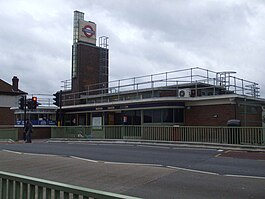Boston Manor tube station
| Boston Manor |
|
|---|---|
 |
|
|
Location of Boston Manor in Greater London
|
|
| Location | Boston Manor |
| Local authority | London Borough of Hounslow |
| Managed by | London Underground |
| Number of platforms | 2 |
| Fare zone | 4 |
| London Underground annual entry and exit | |
| 2012 |
|
| 2013 |
|
| 2014 |
|
| 2015 |
|
| Railway companies | |
| Original company | District Railway |
| Key dates | |
| 1 May 1883 | Opened as Boston Road |
| 11 December 1911 | Renamed Boston Manor |
| 13 March 1933 | Piccadilly line service introduced |
| 9 October 1964 | District line service ceased |
| Listed status | |
| Listing grade | II |
| Entry number | 1063901 |
| Added to list | 21 March 2002 |
| Other information | |
| Lists of stations | |
| WGS84 | 51°29′45″N 0°19′30″W / 51.4958°N 0.325°WCoordinates: 51°29′45″N 0°19′30″W / 51.4958°N 0.325°W |
|
|
|
Boston Manor is a London Underground station serving the Boston Manor area between Brentford and Hanwell in west London. The station is on the Heathrow branch of the Underground's Piccadilly line, between Osterley and Northfields stations. The station is on a street-level bridge over the line on Boston Manor Road (A3002) in the London Borough of Hounslow, just to the south-west of the boundary with the London Borough of Ealing. It is in Travelcard Zone 4.
Boston Manor station was opened by the District Railway (DR), on 1 May 1883 on a line to Hounslow Town (located on Hounslow High Street but now closed). The station was originally named Boston Road. The signs on the platforms gave the name as Boston Manor for Hanwell.
Electrification of the DR's tracks took place between 1903 and 1905 with electric trains replacing steam trains on the Hounslow branch from 13 June 1905. The station was given its current name on 11 December 1911.
Between 1932 and 1934 the station was rebuilt to replace the 1883 station building. The new station was designed by Stanley Heaps in the modern European style used elsewhere on the Piccadilly line by Charles Holden. The design uses brick, reinforced concrete and glass. Occupying a narrow site because of the approach to the adjoining depot, the station was built out over the tracks. The distinctive tower feature, with an illuminated leading edge and roundel rises high above the low structure and helps identify the station from a distance, was strongly influenced by contemporary Dutch and German architecture and was intended to create a landmark building amid an area of low-rise suburban housing.
...
Wikipedia

